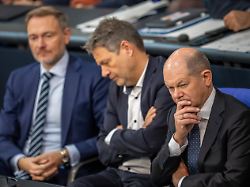The traffic light coalition will not be able to get a budget through the Bundestag this year. This is just the temporary climax in the traffic light’s budget crisis, triggered by the historic Constitutional Court ruling on November 15th. But what does that mean now?
What is the situation?
Three weeks ago, the Federal Constitutional Court plunged the traffic light coalition into its worst crisis to date. 60 billion euros had to be removed from the Climate and Transformation Fund (KTF). This is a special fund with which the federal government Wanted to make the economy green, promote electric cars and the railways and finance building renovations. In addition, the economic and stabilization fund also had to be closed as a result of the ruling.
Never before has a federal government had to absorb such a blow. She quickly put together a supplementary budget for the current year and decided to suspend the debt brake. Since then, Chancellor Olaf Scholz, Finance Minister Christian Lindner and Economics Minister Robert Habeck have been trying to agree on a new budget for 2024. Actually, this should happen before Christmas. It is now clear that it will no longer be possible to pass the budget for 2024 in the Bundestag this year.
This is because the necessary legislative process takes time and cannot be rushed through. The Federal Constitutional Court had already warned about this – with a ruling last summer. It is still possible that the traffic light leaders will fundamentally agree before Christmas and the Bundestag will approve the budget in January. Therefore there will be a provisional budget management. The state will continue to provide regular expenses such as pensions, student loans and citizens’ benefits, but the finance minister must approve everything else.
How much money is missing?
Lindner commented on this for the first time last week. Accordingly, it is about 17 billion euros. In interviews with the Bavarian Radio and the “Business Week” but now he made it more precise. This money is missing for the 2024 budget and is only partly due to the ruling of the Constitutional Court. Six billion euros would come from additional spending on citizens’ money, and three billion euros from reducing electricity taxes. Lindner emphasized that this should have been negotiated anyway. This sum has nothing to do with the KTF billions.
Why does it take so long?
On the one hand, this is because there is little leeway. 380 of the 450 billion euros in the budget for the coming year are statutory benefits, as Lindner told “Wirtschaftswoche”. There’s nothing that can be done about it in the short term, and even if a way could be found, it would require “political unity,” he added. But they don’t exist. The three traffic light parties set their priorities completely differently. The FDP is strictly against tax increases and a renewed suspension of the debt brake. The SPD does not want to cut social benefits and the Greens insist on climate protection measures.
What role does the Climate and Transformation Fund play?
The Karlsruhe ruling was a serious blow for the Climate and Transformation Fund (KTF), because it was something like the business basis of the traffic light. He made it possible for all three parties to get what they wanted. Habeck was able to plan expensive climate neutrality projects without having to lift the debt brake. The latter is the FDP’s most important concern. This left room in the budget for citizens’ money, which the SPD wanted to introduce. As a result of the ruling, 60 billion euros had to be deleted because they were originally intended to combat the economic consequences of the Corona crisis and, in the opinion of the Federal Constitutional Court, should not have been reallocated. In addition, the debts should not have been taken on in reserve.
How much money is left?
According to budget documents, it would have to be around 39 billion euros. The money comes from two sources: money flows into the KTF from CO2 pricing in Germany and European emissions trading. According to the draft budget for the coming year, that should happen next year 19.1 billion euros. In addition, there is already a reserve there. Before the verdict, this amounted to 80 billion euros, including additional global revenue. Since 60 billion euros are now gone, 20 billion remain. Accordingly, around 39 billion euros would be available for 2024. However, the plan was to spend a total of 57.6 billion euros in 2024. According to information from ntv, the deficit is actually smaller than these figures suggest. Accordingly, 12 billion euros are missing. Either way, there are two huge holes: one in the household and one in the KTF.
Is there enough money in the KTF?
That is now the question. The tendency is towards no. Habeck, Lindner and Scholz are working on a new economic plan for the KTF. This is a list of how much money is spent, when and on what. Until then, the fund was blocked. Everything that has already been legally binding remains valid, said Lindner. The rest is under scrutiny.
On Sunday, Habeck said on ARD: “In the conversations we’re having, we’re really trying to identify, in depth from budget tables or the climate and transformation fund, what might come later, what you might not even want to do anymore or can.” What is piquant is that the KTF should also pay for important issues such as the subsidies for Intel and TSMC chip factories near Magdeburg and Dresden. Saxony-Anhalt’s Prime Minister Reiner Haseloff has already said that Scholz had assured him and Saxon Prime Minister Michael Kretschmer that the agreed subsidies would remain.
Immediately after the verdict, Finance Minister Christian Lindner blocked the KTF and announced that he would develop a new economic plan. Habeck emphasized that commitments already made for the coming year could be kept.
